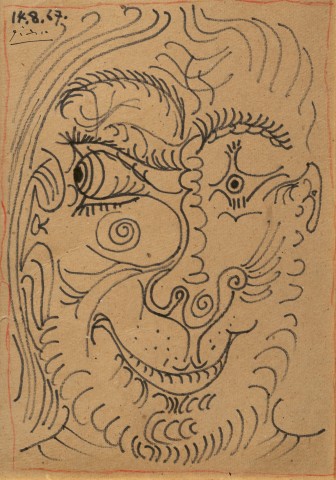TÊTE, 1967
PABLO PICASSO
felt tipped pen and pastel on card
29.5 x 20.0 cm (sight)
30.8 x 21.8 cm (sheet)
signed and dated upper left: 14.8.67 / Picasso
accompanied by a certificate of authenticity from the artist’s son
signed and dated by Claude Ruiz Picasso, 1 April 2014
Private collection, Spain
Nicholas Gallery, Belfast, Ireland (label attached verso)
Private collection, Melbourne, acquired from the above
With cheeky twinkling eyes, a mischievous smile and swirling hirsute features, Picasso’s felt-tip pen drawing, Tête, 1967, is a swift portrait of the elderly artist’s alter ego, bearded and satyr-like. Aged well into his eighth decade, Picasso found an astounding burst of frenetic energy, producing a vast series of prints known as Suite 347 in 1968, focussed on the female nude and power of the artist’s gaze. Alongside these prints, Picasso produced a number of intimate symbolic (self) portraits acting out the role of the artist, many inspired by the works of the grand masters of the past.
Prompted by the unflinching self-introspection of Rembrandt’s late self-portraits, Picasso’s self-representations from this period are characterised by a sardonic, costumed masquerades, and a caricatural appraisal of his advancing age and voyeuristic dynamics with young muses in the studio.1 Tête is closely related to a series of ink on paper portraits of a musketeer, called Head of a Man.2 This suite shows a progressive portrait of a bearded man with a hat, based on a famous portrait of Rembrandt. The man’s features are evoked with increasingly abstract and profusive curlicued lines, the final point an almost identical mythological metamorphosis to that found in Tête.
Rapidly and emphatically executed, this portrait is almost exclusively created by chains of short, curved lines, spirals and sweeping concatenated waves. It is closely cropped, with the outermost edges of the radiating lines reaching the edge of the paper contained only by a delicate red pastel border. Fixed points amongst these swirling lines of wrinkles and hair are the eyes, often wide-open and staring directly at the viewer. In Tête, the locked gaze comes from the right eye’s concentric circles, while the larger, lashed, left eye peers greedily over the shoulder and beyond the frame. As the artist David Hockney noted of Picasso’s late works, ‘I realised it’s about intense looking, what it does and what it can do’.3
Although Picasso was never bearded, his swashbuckling avatars within these 1960s works featured a bushy beard, a broad flattened face and snub nose, concentric wrinkles and swirling eyes. A pockmarked upper lip and upraised nostrils give the impression of an animal muzzle, a slightly simian aspect. Mythological creatures appeared throughout Pablo Picasso’s oeuvre, the artist drawn to their playfulness and tragi-comedic narrative potential. With passionate intensity, the emphatic, repeated curved lines serve a dual purpose, evoking a hairy, leering Silenus figure, while also creating a hypnotic effect. Beyond the mask of charades and self-mocking caricature, Picasso presents himself (albeit metaphorically) with candour and humility, accepting the perils of his advancing age with an endearing and self-deprecating humour.
1. Varnedoe, K., ‘Picasso’s Self Portraits’, in Rubin, W. (ed.), Picasso and Portraiture: Representation and Transformation, Museum of Modern Art, New York and Thames and Hudson, London, 1996, p. 161
2. Head of a Man, 1969, ink on paper, 30. 5 x 24.0 cm, Zervos XXXI, 210, private collection, illus. in Rubin, ibid., p. 164
3. Hockney, D., ‘ Picasso: Or, the Important Paintings of the 1960s’, in David Hockney, London, Academy Press, 1988, p. 83
LUCIE REEVES-SMITH
